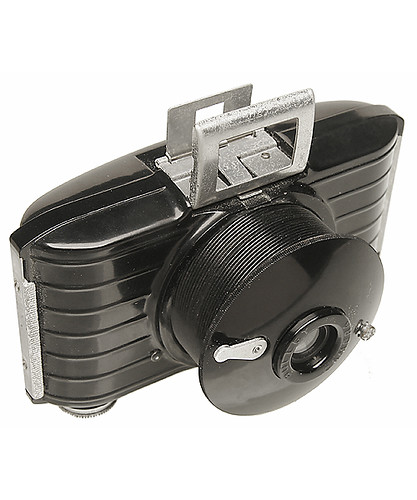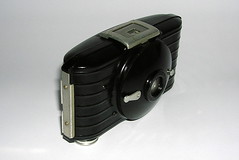Difference between revisions of "Kodak Bullet"
(larger image; layout; smoothed some clumsy english) |
|||
| Line 1: | Line 1: | ||
{{Flickr_image | {{Flickr_image | ||
|image_source= http://www.flickr.com/photos/ricksoloway/366036622/in/pool-camerawiki/ | |image_source= http://www.flickr.com/photos/ricksoloway/366036622/in/pool-camerawiki/ | ||
| − | |image= http://farm1.static.flickr.com/127/ | + | |image= http://farm1.static.flickr.com/127/366036622_656baa8fa9.jpg |
| − | |image_align= | + | |image_align= right |
|image_text= Kodak Bullet | |image_text= Kodak Bullet | ||
|image_by=Rick Soloway | |image_by=Rick Soloway | ||
|image_rights= With permission | |image_rights= With permission | ||
}} | }} | ||
| − | |||
| − | |||
| − | |||
| − | |||
| − | |||
| − | |||
| − | |||
| − | |||
| − | This small 127 (4 × 6 1/2 cm) | + | This small 127 (4 × 6 1/2 cm) camera from 1936 is a fine example of the Art Deco design motifs of the era. It is part of a family of [[Kodak]] models styled by [[Walter Dorwin Teague]], together with the [[Kodak Baby Brownie]] and [[Kodak Bantam]]. |
| + | |||
| + | The design of the [[Bakelite]] Kodak Bullet is very simple. A helicoid lens barrel can retract into the body; the shutter release lever sits alongside the simple meniscus lens. To change the film, the entire back is removed. Two versions exist: one with a sliding catch on one side and a corresponding (but not functional) catch-bar on the other; the second version omits this decorative bar. | ||
The Bullet name was reused later, as the [[Kodak Brownie Holiday|'''Brownie Bullet''']]. | The Bullet name was reused later, as the [[Kodak Brownie Holiday|'''Brownie Bullet''']]. | ||
| Line 25: | Line 19: | ||
* [http://en.wikipedia.org/wiki/Art_deco Wikipedia: Art Déco] | * [http://en.wikipedia.org/wiki/Art_deco Wikipedia: Art Déco] | ||
* [http://en.wikipedia.org/wiki/Walter_Dorwin_Teague Wikipedia: Walter Dorwin Teague] | * [http://en.wikipedia.org/wiki/Walter_Dorwin_Teague Wikipedia: Walter Dorwin Teague] | ||
| + | |||
| + | |||
| + | {{Flickr_image | ||
| + | |image_source= http://www.flickr.com/photos/jeronimogirona/561528737/ | ||
| + | |image= http://farm2.static.flickr.com/1233/561528737_90157677b0_m.jpg | ||
| + | |image_align= left | ||
| + | |image_text= Kodak Bullet, closed | ||
| + | |image_by=jgs4309976 | ||
| + | |image_rights= With permission | ||
| + | }} | ||
---- | ---- | ||
Revision as of 15:14, 19 August 2011

|
| Kodak Bullet image by Rick Soloway (Image rights) |
This small 127 (4 × 6 1/2 cm) camera from 1936 is a fine example of the Art Deco design motifs of the era. It is part of a family of Kodak models styled by Walter Dorwin Teague, together with the Kodak Baby Brownie and Kodak Bantam.
The design of the Bakelite Kodak Bullet is very simple. A helicoid lens barrel can retract into the body; the shutter release lever sits alongside the simple meniscus lens. To change the film, the entire back is removed. Two versions exist: one with a sliding catch on one side and a corresponding (but not functional) catch-bar on the other; the second version omits this decorative bar.
The Bullet name was reused later, as the Brownie Bullet.
Links
- Bullet design patent by Walter Dorwin Teague
- Bullet at Sylvain Halgand's collection d'appareils
- Wikipedia: Art Déco
- Wikipedia: Walter Dorwin Teague

|
| Kodak Bullet, closed image by jgs4309976 (Image rights) |